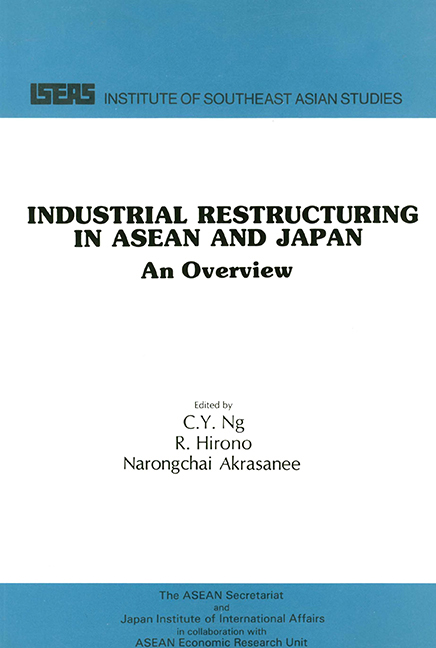Book contents
- Frontmatter
- Contents
- List of Tables
- Foreword
- Preface
- PART ONE ASEAN OVERVIEW
- PART TWO JAPAN OVERVIEW
- 1 JAPAN'S CHANGING INDUSTRIAL STRUCTURE: GROWTH AND DECLINING INDUSTRIES
- 2 CHANGING COMPARATIVE ADVANTAGES
- 3 CORPORATE RESPONSES TO INDUSTRIAL RESTRUCTURING AT HOME AND ABROAD
- 4 INDUSTRIAL RESTRUCTURING POLICY: DOMESTIC DIMENSIONS
- 5 RESTRUCTURING POLICY: INTERNATIONAL DIMENSIONS
- 6 CONCLUSIONS AND RECOMMENDATIONS
- THE EDITORS
4 - INDUSTRIAL RESTRUCTURING POLICY: DOMESTIC DIMENSIONS
from PART TWO - JAPAN OVERVIEW
Published online by Cambridge University Press: 21 October 2015
- Frontmatter
- Contents
- List of Tables
- Foreword
- Preface
- PART ONE ASEAN OVERVIEW
- PART TWO JAPAN OVERVIEW
- 1 JAPAN'S CHANGING INDUSTRIAL STRUCTURE: GROWTH AND DECLINING INDUSTRIES
- 2 CHANGING COMPARATIVE ADVANTAGES
- 3 CORPORATE RESPONSES TO INDUSTRIAL RESTRUCTURING AT HOME AND ABROAD
- 4 INDUSTRIAL RESTRUCTURING POLICY: DOMESTIC DIMENSIONS
- 5 RESTRUCTURING POLICY: INTERNATIONAL DIMENSIONS
- 6 CONCLUSIONS AND RECOMMENDATIONS
- THE EDITORS
Summary
Changes in Industrial Policy
Japanese industrial policy has undergone a major change since the energy crisis in 1973/74. The basic feature of the change is the shift of emphasis from “forward looking” industrial policies to strengthen the international competitiveness of basic industries to the “management-of-market-failure” industrial policies which became necessary with the increase in the number of depressed industries. The former policies tried to set the framework for new, upcoming industries so as to accelerate the introduction of new technologies, the increase in output, and the gain in international competitiveness. The forward-looking industrial policies were designed to contribute to the improvement of the living standard of the people as well as to the acceleration of economic growth.
However, partly because of the enhanced capacity of the private sector to implement their own future industrial development strategies through increased R & D expenditure and overseas investment and partly because of such external developments as the energy crises in the 1970s and the sharp appreciation of the yen in the mid-1980s, the government has been brought under pressure to shift the focus of its industrial policies to the management of declining industries and areas.
Nevertheless, it is important to note that “forward-looking” industrial policies have never been, and probably will never be, abandoned. In fact, forward-looking policies and industrial restructuring policies have always coexisted in post-war Japan. Even before the 1973/74 energy crisis, the restructuring of the coal and textile industries had been important issues for the government, and the promotion of future high-technology industries has also been an important part of the present day government policy. However, the extent of restructuring industries after the energy crisis has been most pervasive, affecting every aspect of social and economic life of the people involved as well as the industries themselves. The main thrust of industrial policies has therefore been directed at industrial restructuring. For analytical purposes, however, it is useful to look into the government policies in the pre- and post-energy crisis periods.
- Type
- Chapter
- Information
- Industrial Restructuring in ASEAN and JapanAn Overview, pp. 91 - 102Publisher: ISEAS–Yusof Ishak InstitutePrint publication year: 1987

